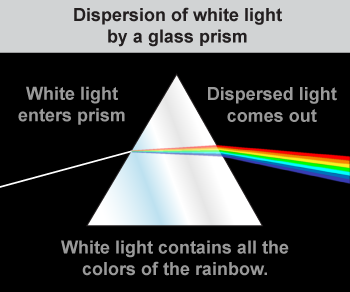|
 Where do all the colors of the rainbow come from? After a rainstorm, on the side of the sky opposite the Sun, you might see a rainbow if you’re lucky. Light from the Sun scatters off of tiny water droplets in the air in such a way that the light is separated into its constituent colors, as you will learn on page 639. Rainbows are revealing something about the fundamental properties of light.
Where do all the colors of the rainbow come from? After a rainstorm, on the side of the sky opposite the Sun, you might see a rainbow if you’re lucky. Light from the Sun scatters off of tiny water droplets in the air in such a way that the light is separated into its constituent colors, as you will learn on page 639. Rainbows are revealing something about the fundamental properties of light. 
|
 The light from a lamp or the Sun may look white (or yellowish-white for the Sun), but white is actually a combination of colors! The perception of white comes from an equal blend of red, green, blue, and other colors, so that no single color dominates. Rather than waiting for a rainbow after the next rainstorm, you can demonstrate that white light contains all colors using a glass prism. The triangular glass shape of a prism disperses each color at a slightly different angle, producing the rainbow of colors.
The light from a lamp or the Sun may look white (or yellowish-white for the Sun), but white is actually a combination of colors! The perception of white comes from an equal blend of red, green, blue, and other colors, so that no single color dominates. Rather than waiting for a rainbow after the next rainstorm, you can demonstrate that white light contains all colors using a glass prism. The triangular glass shape of a prism disperses each color at a slightly different angle, producing the rainbow of colors. 
|
The order of the colors dispersed by a prism—or by a rainbow—is usually remembered by the acronym ROYGBIV. The letters stand for red, orange, yellow, green, blue, indigo, and violet. White light consists of all the colors, whereas blackness—as you can see on a dark, moonless night—is the absence of light. 
|
If white light consists of a blend of colors, then how does the human eye or a digital camera sense that light? How about red light? Yellow light? Magenta? The sensation of color is actually a perception of the energy in light. 
|
 Within the range of visible light, lower energies appear red and higher energies appear blue. The human eye contains three color sensors that send nerve impulses to the brain. The lowest energy sensor responds most strongly to red light, the medium energy sensor to green light, and the highest energy sensor to blue light. There is some overlap in sensitivity, so yellow light stimulates the red and green sensors equally. Your brain “sees” yellow as an equal stimulus from the red and green sensors. A digital image tricks the brain into seeing yellow, and most other colors, using only varying amounts of red, green, and blue.
Within the range of visible light, lower energies appear red and higher energies appear blue. The human eye contains three color sensors that send nerve impulses to the brain. The lowest energy sensor responds most strongly to red light, the medium energy sensor to green light, and the highest energy sensor to blue light. There is some overlap in sensitivity, so yellow light stimulates the red and green sensors equally. Your brain “sees” yellow as an equal stimulus from the red and green sensors. A digital image tricks the brain into seeing yellow, and most other colors, using only varying amounts of red, green, and blue. 
|
Which has higher energy, orange or blue light?
 |
Blue light has higher energy. Remember the acronym ROYGBIV. It describes the colors of the rainbow in order of increasing energy. Since blue comes after orange, it has higher energy! 
|
| |
|

